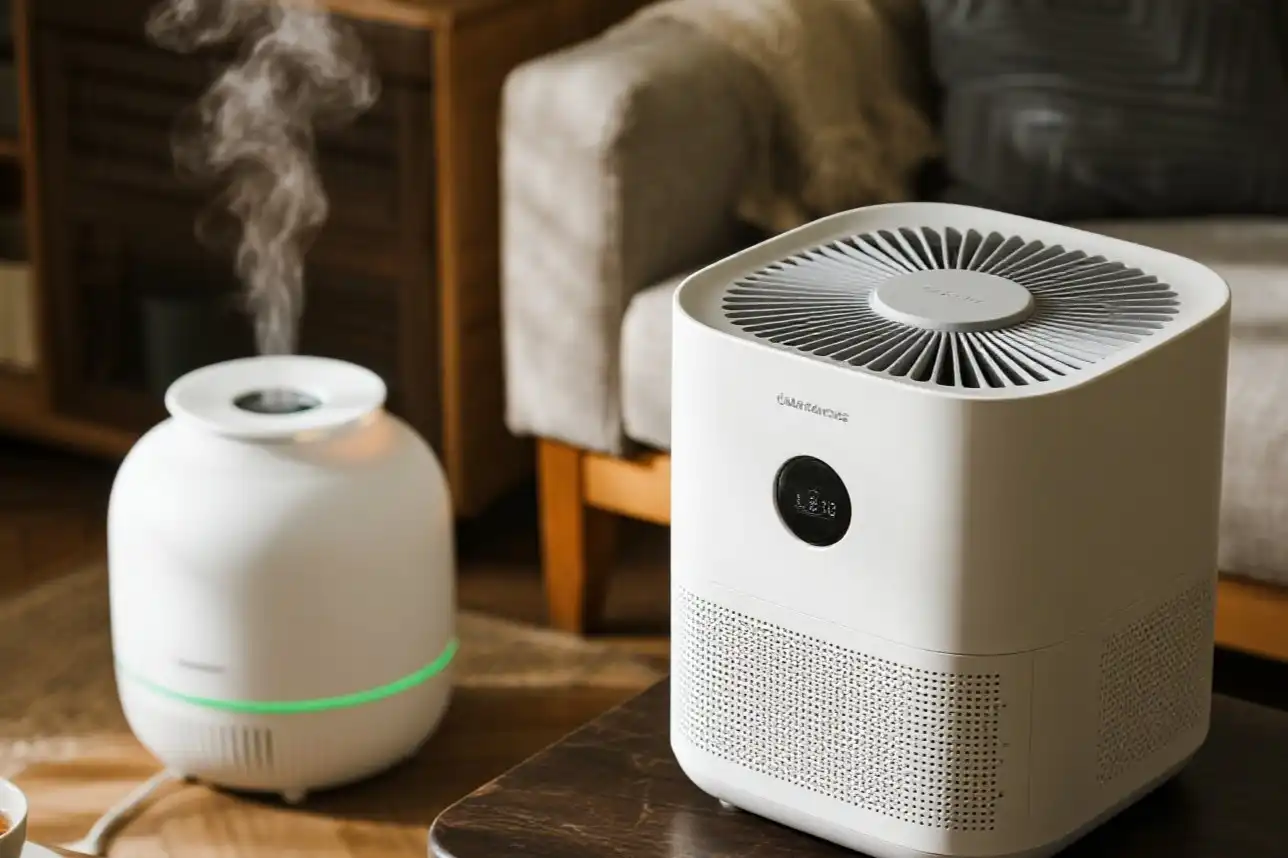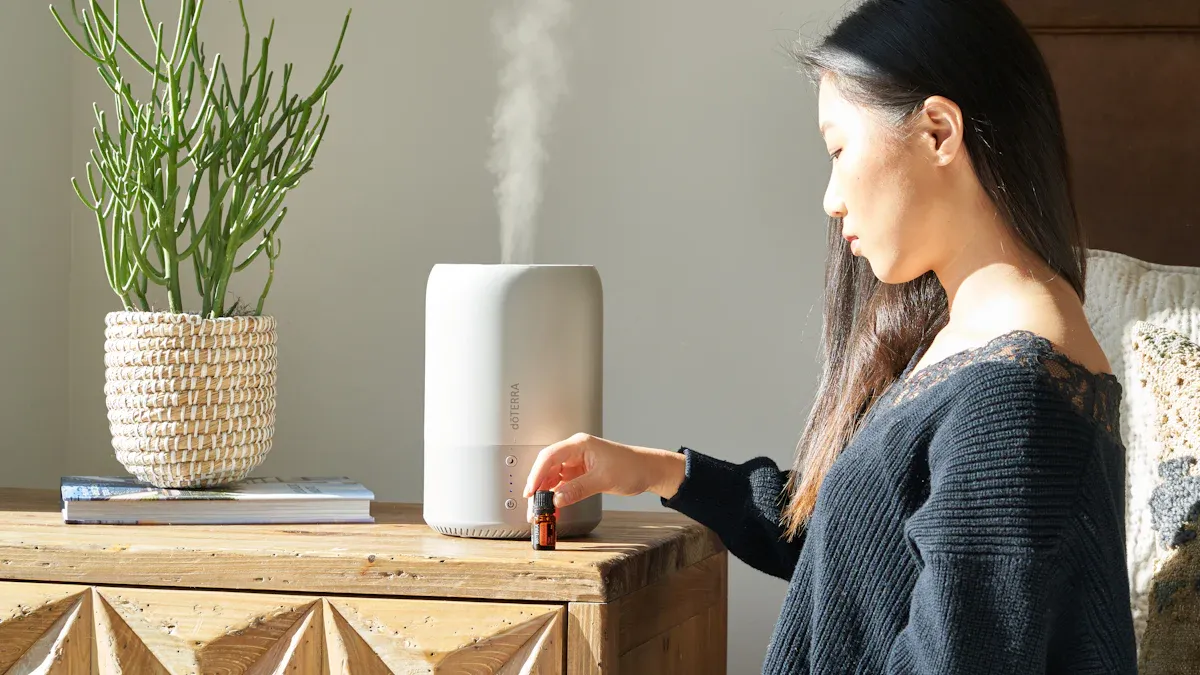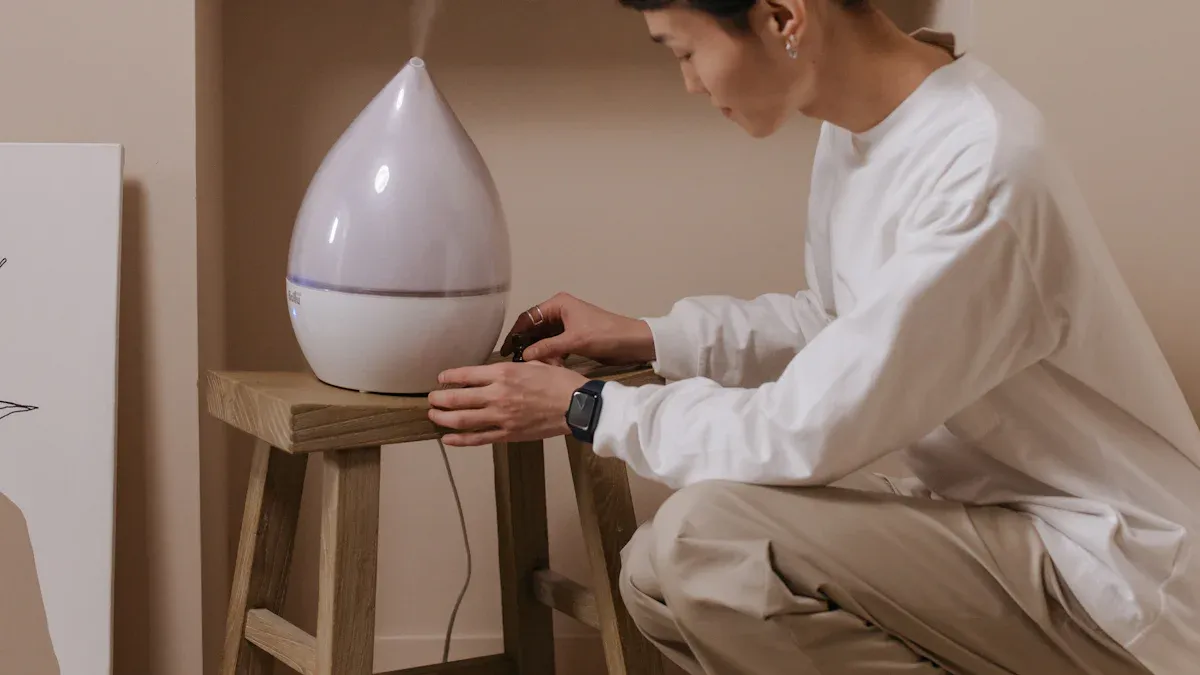
Yes, you can use a humidifier and an air purifier together. These devices help make your home healthier. A humidifier puts water into dry air. An air purifier takes out dust, pollen, and germs from the air. Certified air purifiers like the IQAir HealthPro Series do not make harmful ozone. They work safely with humidifiers to lower pollutants and stop mold or bacteria from growing. Cleaning both devices often keeps them safe and working well.
Key Takeaways
- You can use a humidifier and an air purifier together. This helps make your home’s air cleaner and more comfortable. Keep the humidifier and air purifier at least 3 to 6 feet apart. This stops moisture from hurting the purifier’s filter. Use distilled or filtered water in your humidifier. Clean both devices often to stop mold, germs, and mineral buildup. Keep indoor humidity between 30% and 50%. This stops mold from growing and helps both devices work well. An evaporative humidifier is a good choice with air purifiers. It controls humidity and filters impurities in a natural way.
How They Work

Humidifier Function
A humidifier puts water into the air in your house. There are different kinds, and each works in its own way to make the air wetter. Here is a table that explains how each type works:
| Humidifier Type | Mechanism Description |
|---|---|
| Evaporative | A fan blows air through a wet filter. This makes water turn into vapor. |
| Ultrasonic | It uses fast vibrations to turn water into tiny mist drops. These drops go into the air. |
| Steam Vaporizers | They heat water until it boils. The steam cools a little before going into the air. |
| Impeller | A spinning disk throws water at a part called a diffuser. This makes water droplets that go into the air. |
| Central Humidifiers | These add water right into the air ducts. The whole house gets more moisture through the vents. |
A humidifier can help if you have dry skin or a sore throat. It can also help with sinus problems. When the air has more moisture, it feels nicer to breathe.
Air Purifier Function
An air purifier makes the air cleaner by taking out dust, pollen, smoke, and germs. The best ones use true HEPA filters. These filters catch almost all tiny particles, even ones as small as 0.3 microns. This helps keep you safe from things like allergens and some viruses. Hospitals and labs use air purifiers to keep the air clean for people who need it. Some purifiers use fans to move air through the filter. Others use special systems for bigger rooms.
Tip: Always look for a certified HEPA filter in your air purifier for the best results.
Key Differences
You may want to know how these two devices are not the same. Here is a table to show the main differences:
| Feature/Aspect | Air Purifier | Humidifier |
|---|---|---|
| Primary Function | Cleans air by taking out dust, smoke, allergens, mold, and VOCs | Adds water to the air to stop dryness |
| Ideal For | Good for people with allergies, asthma, or breathing problems. Also good for homes with pets or smoke. | Good for people with dry skin, stuffy nose, or sore throat. Also good for dry or heated rooms. |
| Benefits | Lowers allergens and pollution in the air. Helps you breathe better. | Helps with dry skin, chapped lips, dry eyes, and sore throat. |
| Limitations | Does not add water or help with dry air. | Does not clean the air. Too much water can cause mold. |
| Use Case Recommendation | Best if you want cleaner air and less dust or allergens. | Best if you want to fix dry air and feel more comfortable. |
| Combined Use | You can use both together for clean and moist air. | You can use both together for clean and moist air. |
An air purifier takes out bad stuff from the air. A humidifier puts water into the air. Using both can help make your home healthier.
Benefits
Air Quality Improvement
Using a humidifier and an air purifier together makes your air better. Each one helps with a different problem. The air purifier takes out dust, pollen, pet dander, and germs. The humidifier puts water in the air so it does not get too dry. When you use both, you fix dryness and pollution at once.
- People say they have less dry throat, cough less at night, and have fewer sinus issues when using both.
- Sleep problems go down by about 34% because the air feels cleaner and nicer.
- The two devices help tiny things in the air get wet, so they fall faster. This makes it easier for the air purifier to catch them.
- Keeping the air between 30% and 50% humidity helps the air purifier work better and lowers static electricity.
Tip: Put your humidifier and air purifier in different spots so the mist does not block the purifier filter.
Health and Comfort
You will feel better and healthier when you use both. The humidifier adds water to the air, which helps your skin, eyes, and throat. The air purifier takes out bad stuff, so you breathe cleaner air.
- Skin doctors say using both helps your skin stay healthy by keeping out bad things and holding in moisture.
- The right amount of water in the air helps your body fight germs. Your nose and throat stay wet, so germs have a harder time getting in.
- Kids and older people feel better and breathe easier with clean, moist air.
Allergy and Asthma Relief
If you have allergies or asthma, both devices can help you. The air purifier takes out things like pollen, pet dander, and dust mites. The humidifier keeps your nose and throat from getting too dry, which helps stop irritation.
- People with allergies say they have fewer problems because the air purifier takes out allergens and the humidifier stops dryness.
- People with asthma have fewer attacks and less dry airways.
- Keeping the air between 40% and 60% humidity helps stop mold and dust mites, which can make allergies worse.
- Using both also helps you sleep better and feel less stressed because the air is more comfortable.
Humidifier Placement and Safety

Distance from Air Purifier
Keep your humidifier and air purifier apart in the room. If they are too close, the air purifier filter can get wet. A wet filter can trap water and let mold or bacteria grow. This makes the air in your home worse. Put the humidifier on one side of the room. Place the air purifier on the other side. Make sure the mist does not blow at the air purifier. This way, both devices work well and keep your air clean.
Tip: Keep your air purifier at least 3 to 6 feet away from the humidifier. This helps stop the filter from getting wet.
Preventing Mold and Moisture Issues
You can stop mold and moisture problems by doing a few things. Mold grows when the air is too wet. You should keep the humidity between 30% and 50%. This helps stop mold and keeps your home nice. Use a hygrometer to check the humidity in rooms with a humidifier. If you see water on windows or walls, lower the humidity.
Here are the best ways to stop mold:
- Keep humidity between 30% and 50%.
- Use dehumidifiers in wet places to control extra water.
- Check humidity with a hygrometer in rooms with lots of moisture.
- Make sure your home has good airflow by using fans and opening windows.
- Seal windows and doors to keep outside water out.
- Use fans when cooking or showering to remove extra humidity.
Pick the right humidifier for your home. Evaporative humidifiers work best with air purifiers. They use a wick filter to catch bad stuff and help control humidity. Ultrasonic humidifiers can spread minerals and germs if you do not use distilled water or clean them often. The table below shows how evaporative and ultrasonic humidifiers are different:
| Feature | Evaporative Humidifiers | Ultrasonic Humidifiers |
|---|---|---|
| Filtration | Naturally filter impurities through wick filter | Can disperse minerals and contaminants if water is untreated |
| Humidity Control | Self-regulating, reduces risk of over-humidification | Can over-humidify if not monitored |
| Air Quality | Improves air quality by reducing allergens and irritants | May disperse white dust and bacteria if not cleaned properly |
| Noise Level | Noisier due to fan | Whisper-quiet operation |
| Maintenance | Requires regular filter replacement | Requires frequent cleaning to prevent bacterial growth |
| Cost | Generally more cost-effective upfront | Higher upfront cost but no filter replacement needed |
| Energy Efficiency | Uses more energy due to fan | More energy-efficient |
Filter Care
Take care of your air purifier and humidifier to keep them working. Cleaning stops mold, germs, and dust from building up. Clean and change filters as the maker says. The table below shows how often to clean or change each part of your air purifier:
| Filter Type | Recommended Frequency | Notes |
|---|---|---|
| Main Filters | Every 6–12 months | Change when airflow reduces; captures fine particles (0.3 microns) |
| Activated Carbon | Every 3–6 months | Replace when odors linger; absorbs gases and chemicals |
| Pre-filters | Vacuum every 1–3 months | Captures larger particles; protects main filters from clogging |
| Exterior Cleaning | Every 2–4 weeks | Wipe with damp microfiber cloth; avoid moisture in vents |
| Interior Disinfection | Every 3–6 months | Important in humid environments to prevent mold; use bleach solution or disinfectant |
For your humidifier, clean the tank and change the filter or pad at least once a year. If you use hard water, clean more often to remove minerals. Always unplug before cleaning and keep water away from electric parts. Run your air purifier often to keep the air fresh.
Note: Keeping humidity between 40% and 50% helps your air purifier work better. This also keeps your home comfy and safe from water damage. It helps stop dry air problems too.
Practical Tips
Setup Best Practices
You can use a humidifier and air purifier in one room. They work well together and do not cause problems. Put the humidifier on one side of the room. Place the air purifier on the other side. This keeps the air purifier’s filter dry. Try to use an evaporative humidifier if you can. It does not put minerals or dust in the air. Always fill your humidifier with distilled or filtered water. This stops minerals from building up and keeps the air clean.
- Keep the devices 3 to 6 feet apart.
- Do not let the humidifier’s mist blow at the air purifier.
- Use both in winter for dry, dirty air or in allergy season for pollen.
- Clean both often to stop mold and germs.
Tip: Using both devices can lower viruses in the air and make your home healthier.
Monitoring and Adjustments
Check the humidity in your home often. Use a hygrometer to see the humidity level. Experts say to keep humidity between 30% and 50%. Change your humidifier settings for the season and your health. Lower the humidity in winter when the air is dry. Raise it in summer if air conditioning makes the air dry. If you see water on windows or walls, turn down the humidifier.
| Season | Recommended Humidity (%) |
|---|---|
| Winter | 30–40 |
| Spring/Fall | 40–50 |
| Summer | 40–50 |
Note: The right humidity helps stop dry skin, keeps viruses from spreading, and makes it easier to breathe.
Common Mistakes
People sometimes make mistakes when using both devices. Try not to do these things:
- Putting the humidifier too close to the air purifier, which can make the filter wet.
- Using tap water in ultrasonic humidifiers, which can put minerals in the air.
- Not cleaning the devices, which can cause mold, germs, or mineral buildup.
- Not thinking about noise, which can bother sleep or daily life.
- Not checking humidity, which can cause mold or dry air.
Always follow the maker’s rules for cleaning and care. Good habits keep your air clean and your devices working well.
You can use both devices together to get cleaner air. This helps make your home healthier. Studies say air purifiers work well with different humidity. They do not make the air dry. Put each device on a different side of the room. Clean them often to stop filter damage and mold.
- Putting them in the right spots helps air move and keeps filters dry.
- Cleaning and checking humidity often makes your home safer and more comfy.
- Using air purifiers all day keeps the air good.
FAQ
What happens if you put a humidifier too close to an air purifier?
If you place your humidifier too close to your air purifier, the filter may get wet. This can cause mold or bacteria to grow inside the purifier. Always keep at least 3 to 6 feet between the two devices.
What type of water should you use in a humidifier?
You should use distilled or filtered water in your humidifier. Tap water can leave mineral deposits and create white dust. Using clean water helps keep your air and device safe.
What is the best humidity level for using both devices?
Aim for a humidity level between 30% and 50%. This range keeps your air comfortable and helps your air purifier work better. Use a hygrometer to check the humidity in your room.
What maintenance do both devices need?
You need to clean both devices often. Change filters as the manufacturer recommends. Wipe the outside with a damp cloth. Clean the humidifier tank and parts to stop mold and bacteria.
What signs show you need to adjust your setup?
Look for water on windows, musty smells, or dust buildup. These signs mean you should check your humidity, clean your devices, or move them farther apart.
See also
Air Sanitizer or Air Purifier What’s the Right Choice for You in 2025
Things to Consider Before Buying an AQI Sensor Air Purifier with Display
